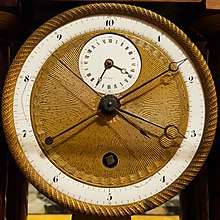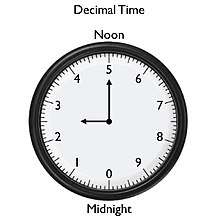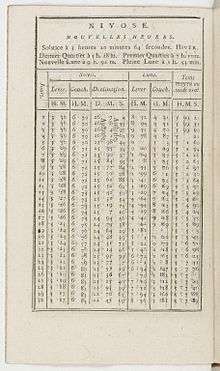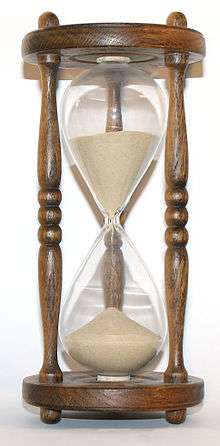Decimal time
Decimal time is the representation of the time of day using units which are decimally related. This term is often used specifically to refer to the time system used in France for a few years beginning in 1792 during the French Revolution, which divided the day into 10 decimal hours, each decimal hour into 100 decimal minutes and each decimal minute into 100 decimal seconds (100000 decimal seconds per day), as opposed to the more familiar UTC time standard, which divides the day into 24 hours, each hour into 60 minutes and each minute into 60 seconds (86400 SI seconds per day).
| GMT at page generation () | |
|---|---|
| 24-hour time | Decimal time |
| 09:52:43 | 4:11:60 |
| 4h 11m 60s | |
| 0.41160 d | |


The main advantage of a decimal time system is that, since the base used to divide the time is the same as the one used to represent it, the whole time representation can be handled as a single string. Therefore, it becomes simpler to interpret a timestamp and to perform conversions. For instance, 1:23:45 is 1 decimal hour and 23 decimal minutes and 45 decimal seconds, or 1.2345 decimal hours, or 123.45 decimal minutes or 12345 decimal seconds; 3 hours is 300 minutes or 30,000 seconds. This property also makes it straightforward to represent a timestamp as a fractional day, so that 2020-08-17.54321 can be interpreted as five decimal hours and 43 decimal minutes and 21 decimal seconds after the start of that day, or a fraction of 0.54321 (54.321%) through that day. It also adjusts well to digital time representation using epochs, in that the internal time representation can be used directly both for computation and for user-facing display.
| decimal | 24-hour | 12-hour |
|---|---|---|
| 0 (midnight) | 00:00 | 12:00 a.m. |
| 1 | 02:24 | 2:24 a.m. |
| 2 | 04:48 | 4:48 a.m. |
| 3 | 07:12 | 7:12 a.m. |
| 4 | 09:36 | 9:36 a.m. |
| 5 (noon) | 12:00 | 12:00 p.m. |
| 6 | 14:24 | 2:24 p.m. |
| 7 | 16:48 | 4:48 p.m. |
| 8 | 19:12 | 7:12 p.m. |
| 9 | 21:36 | 9:36 p.m. |
History
China
Decimal time was used in China throughout most of its history alongside duodecimal time. The midnight-to-midnight day was divided both into 12 double hours (traditional Chinese: 時辰; simplified Chinese: 时辰; pinyin: shí chén) and also into 10 shi / 100 ke (Chinese: 刻; pinyin: kè) by the 1st millennium BC.[1][2] Other numbers of ke per day were used during three short periods: 120 ke from 5–3 BC, 96 ke from 507–544 CE, and 108 ke from 544–565. Several of the roughly 50 Chinese calendars also divided each ke into 100 fen, although others divided each ke into 60 fen. In 1280, the Shoushi (Season Granting) calendar further subdivided each fen into 100 miao, creating a complete decimal time system of 100 ke, 100 fen and 100 miao.[3] Chinese decimal time ceased to be used in 1645 when the Shixian (Constant Conformity) calendar, based on European astronomy and brought to China by the Jesuits, adopted 96 ke per day alongside 12 double hours, making each ke exactly one-quarter hour.[4]
France

In 1754, Jean le Rond d'Alembert wrote in the Encyclopédie:
- It would be very desirable that all divisions, for example of the livre, the sou, the toise, the day, the hour, etc. would be from tens into tens. This division would result in much easier and more convenient calculations and would be very preferable to the arbitrary division of the livre into twenty sous, of the sou into twelve deniers, of the day into twenty-four hours, the hour into sixty minutes, etc.[5][6]
In 1788, Claude Boniface Collignon proposed dividing the day into 10 hours or 1000 minutes, each new hour into 100 minutes, each new minute into 1000 seconds, and each new second into 1000 tierces (Latin for "third"). The distance the twilight zone travels in one such tierce at the equator, which would be one-billionth of the circumference of the earth, would be a new unit of length, provisionally called a half-handbreadth, equal to four modern centimetres. Further, the new tierce would be divided into 1000 quatierces, which he called "microscopic points of time". He also suggested a week of 10 days and dividing the year into 10 "solar months".[7]
Decimal time was officially introduced during the French Revolution. Jean-Charles de Borda made a proposal for decimal time on November 5, 1792. The National Convention issued a decree on 5 October 1793:
- XI. Le jour, de minuit à minuit, est divisé en dix parties, chaque partie en dix autres, ainsi de suite jusqu’à la plus petite portion commensurable de la durée.
- XI. The day, from midnight to midnight, is divided into ten parts, each part into ten others, and so forth until the smallest measurable portion of duration.
These parts were named on 24 November 1793 (4 Frimaire of the Year II). The primary divisions were called hours, and they added:
- La centième partie de l'heure est appelée minute décimale; la centième partie de la minute est appelée seconde décimale. (emphasis in original)
- The hundredth part of the hour is called decimal minute; the hundredth part of the minute is called decimal second.
Thus, midnight was called either dix heures ("ten hours") or zero heures, noon was called cinq heures ("five hours"), etc. Units were either written out or abbreviated, such as 8 h. 72 m. Sometimes in official records, decimal hours were divided into tenths, or décimes, instead of minutes (e.g., 8.7 h.).[8][9] Although clocks and watches were produced with faces showing both standard time with numbers 1–24 and decimal time with numbers 1–10, decimal time never caught on; it was not officially used until the beginning of the Republican year III, 22 September 1794, and mandatory use was suspended 7 April 1795 (18 Germinal of the Year III), in the same law which introduced the original metric system. Thus, although decimal time is sometimes referred to as metric time, the metric system at first had no time unit, and later versions of the metric system used the second, equal to 1/86400 day, as the metric time unit. In spite of this, decimal time was used in many cities, including Marseille and Toulouse, where a decimal clock with just an hour hand was on the front of the Capitole for five years.[8] On the Palace of the Tuileries in Paris, two of the four clock faces displayed decimal time until at least 1801.[10] The mathematician and astronomer Pierre-Simon Laplace had a decimal watch made for him, and used decimal time in his work, in the form of fractional days.
Decimal time was part of a larger attempt at decimalisation in revolutionary France (which also included decimalisation of currency and metrication) and was introduced as part of the French Republican Calendar, which, in addition to decimally dividing the day, divided the month into three décades of 10 days each; this calendar was abolished at the end of 1805. The start of each year was determined according to the day of the autumnal equinox, in relation to true or apparent solar time at the Paris Observatory. Decimal time would also have been reckoned according to apparent solar time, depending on the location it was observed, as was already the practice generally for the setting of clocks. 09:52:43 GMT is 4 h 18 min 10 s decimal time in Paris.
At the International Meridian Conference of 1884, the following resolution was proposed by the French delegation and passed nem con (with 3 abstentions):
- VII. That the Conference expresses the hope that the technical studies designed to regulate and extend the application of the decimal system to the division of angular space and of time shall be resumed, so as to permit the extension of this application to all cases in which it presents real advantages.
In the 1890s, Joseph Charles François de Rey-Pailhade, president of the Toulouse Geographical Society, proposed dividing the day into 100 parts, called cés, equal to 14.4 standard minutes, and each divided into 10 decicés, 100 centicés, etc. The Toulouse Chamber of Commerce adopted a resolution supporting his proposal in April 1897. Although widely published, the proposal received little backing.[11]
The French made another attempt at the decimalization of time in 1897, when the Commission de décimalisation du temps was created by the Bureau des Longitudes, with the mathematician Henri Poincaré as secretary. The commission adopted a compromise, originally proposed by Henri de Sarrauton of the Oran Geographical Society, of retaining the 24-hour day, but dividing each hour into 100 decimal minutes, and each minute into 100 seconds. The plan did not gain acceptance and was abandoned in 1900.
Switzerland
On 23 October 1998, the Swiss watch company Swatch introduced a decimal time called Internet Time, which divides the day into 1,000 decimal minutes (Swatch called them .beats), (each 86.4 seconds in standard time) counted from 000–999, with @000 being midnight and @500 being noon standard time in Switzerland, which is Central European Time (one hour ahead of Universal Time). A line painted on Swatch headquarters in the Swiss city of Biel (now Biel/Bienne) was declared to mark the Biel Meridian, and Central European Time was relabelled as "Biel Meantime" (BMT), even though it does not correspond to actual local mean time in Biel.[12]
Conversions
There are exactly 86,400 standard seconds (see SI for the current definition of the standard second) in a standard day, but in the French decimal time system there were 100,000 decimal seconds in the day, so the decimal second was shorter than its counterpart.
| Decimal unit | Seconds | Minutes | Hours | h:mm:ss.sss |
|---|---|---|---|---|
| Decimal second | 0.864 | 0.0144 | 0.00024 | 0:00:00.864 |
| Decimal minute | 86.4 | 1.44 | 0.024 | 0:01:26.400 |
| Decimal hour | 8,640 | 144 | 2.4 | 2:24:00.000 |
Decimal hours
Another common type of decimal time is decimal hours. In 1896, Henri de Sarrauton of the Oran Geographical Society proposed dividing the 24 hours of the day each into 100 decimal minutes, and each minute into 100 decimal seconds.[13] Although endorsed by the Bureau des Longitudes, this proposal failed, but using decimal fractions of an hour to represent the time of day instead of minutes has become common.
Decimal hours are frequently used in accounting for payrolls and hourly billing. Time clocks typically record the time of day in tenths or hundredths of an hour. For instance, 08:30 would be recorded as 08.50. This is intended to make accounting easier by eliminating the need to convert between minutes and hours.
For aviation purposes, where it is common to add times in an already complicated environment, time tracking is simplified by recording decimal fractions of hours. For instance, instead of adding 1:36 to 2:36, getting 3:72 and converting it to 4:12, one would add 1.6 to 2.6 and get 4.2 hours.[14]
Fractional days
The time of day is sometimes represented as a decimal fraction of a day in science and computers. Standard 24-hour time is converted into a fractional day by dividing the number of hours elapsed since midnight by 24 to make a decimal fraction. Thus, midnight is 0.0 day, noon is 0.5 d, etc., which can be added to any type of date, including (all of which refer to the same moment):
- Gregorian dates: 2000 January 1.5
- Two-line elements: 00001.50000000
- Julian dates: 2451545.0
- Excel serial dates: 36526.5
As many decimal places may be used as required for precision, so 0.5 d = 0.500000 d. Fractional days are often calculated in UTC or TT, although Julian Dates use pre-1925 astronomical date/time (each date began at noon = ".0") and Microsoft Excel uses the local time zone of the computer. Using fractional days reduces the number of units in time calculations from four (days, hours, minutes, seconds) to just one (days).
Fractional days are often used by astronomers to record observations, and were expressed in relation to Paris Mean Time by the 18th century French mathematician and astronomer Pierre-Simon Laplace, as in these examples:[15]
... et la distance périhélie, égale à 1,053095 ; ce qui a donné pour l'instant du passage au périhélie, sept.29j,10239, temps moyen compté de minuit à Paris.
Les valeurs précédentes de a, b, h, l, relatives à trois observations, ont donné la distance périhélie égale à 1,053650; et pour l'instant du passage, sept.29j,04587; ce qui diffère peu des résultats fondés sur cinq observations.
— Pierre-Simon Laplace, Traité de Mécanique Céleste
Fractional days have been used by astronomers ever since. For instance, the 19th century British astronomer John Herschel gave these examples:[16]
Between Greenwich noon of the 22d and 23d of March, 1829, the 1828th equinoctial year terminates, and the 1829th commences. This happens at 0d·286003, or at 6h 51m 50s·66 Greenwich Mean Time ... For example, at 12h 0m 0s Greenwich Mean Time, or 0d·500000...
— John Herschel, Outlines of Astronomy
Fractional days are commonly used to express epochs of orbital elements. The decimal fraction is usually added to the calendar date or Julian day for natural objects, or to the ordinal date for artificial satellites in two-line elements.
Decimal multiples and fractions of the second
The second is the International System of Units (SI) unit of time duration. It is also the standard single-unit time representation in many programming languages, most notably C, and part of UNIX/POSIX standards used by Linux, Mac OS X, etc.; to convert fractional days to fractional seconds, multiply the number by 86400. Fractional seconds are represented as milliseconds (ms), microseconds (μs) or nanoseconds (ns). Absolute times are usually represented relative to 1 January 1970, at midnight. Other systems may use a different zero point (like Unix time).
In principle, time spans greater than one second are given in units such as kiloseconds (ks), myriasecond (mys), megaseconds (Ms), gigaseconds (Gs), and so on. (The myriasecond is based on the myria- prefix, which represented a multiple of 10000 but was made obsolete in the mid-20th century.) Occasionally, these units can be found in technical literature, but traditional units like minutes, hours, days and years are much more common, and are accepted for use with SI.
It is possible to specify the time of day as the number of kiloseconds or myriaseconds elapsed since midnight. Thus, instead of saying 3:45 p.m. one could say (time of day) 56.7 ks. There are exactly 86.4 ks or 8.64 mys in one day. However, this nomenclature is rarely used in practice.
Scientific decimal time
Scientists often record time as decimals. For example, decimal days divide the day into 10 equal parts, and decimal years divide the year into 10 equal parts. Decimals are easier to plot than both (a) minutes and seconds, which uses the sexagesimal numbering system, (b) hours, months and days, which has irregular month lengths. In astronomy, the so-called Julian day uses decimal days centered on Greenwich noon.
- Seconds in a decimal minute
Since there are 60 seconds in a minute, a tenth part represents 60/10 = 6 seconds.
| Decimal minutes | 0.1 | 0.2 | 0.3 | 0.4 | 0.5 | 0.6 | 0.7 | 0.8 | 0.9 | 1.0 |
|---|---|---|---|---|---|---|---|---|---|---|
| Second | 6s | 12s | 18s | 24s | 30s | 36s | 42s | 48s | 54s | 60s |
- Minutes in a decimal hour
Since there are 60 minutes in an hour, a tenth part represents 60/10 = 6 minutes.
| Decimal hours | 0.1 | 0.2 | 0.3 | 0.4 | 0.5 | 0.6 | 0.7 | 0.8 | 0.9 | 1.0 |
|---|---|---|---|---|---|---|---|---|---|---|
| Minutes | 6m | 12m | 18m | 24m | 30m | 36m | 42m | 48m | 54m | 60m |
- Hours in a decimal day
Since there are 24 hours in a day, a tenth part represents 24/10 = 2.4 hours (2 hours and 24 minutes).
| Decimal days | 0.1 | 0.2 | 0.3 | 0.4 | 0.5 | 0.6 | 0.7 | 0.8 | 0.9 | 1.0 |
|---|---|---|---|---|---|---|---|---|---|---|
| Hours/minutes | 2h 24m | 4h 48m | 7h 12m | 9h 36m | 12h | 14h 24m | 16h 48m | 19h 12m | 21h 36m | 24h |
- Length of a decimal year
Since there are about 365 days in a year, there are about 365/10 = 36.5 days in a tenth of a year. Hence the year 2000.5 represents the day 2 July 2000.[17] More exactly, a “Julian year” is exactly 365.25 days long, so a tenth of the year is 36.525 days (36 days, 12 hours, 36 minutes).
| Decimal years | 0.0 | 0.1 | 0.2 | 0.3 | 0.4 | 0.5 | 0.6 | 0.7 | 0.8 | 0.9 | 1.0 |
|---|---|---|---|---|---|---|---|---|---|---|---|
| Days | 0 | 36.525 | 73.050 | 109.575 | 146.100 | 182.625 | 219.150 | 255.675 | 292.200 | 328.725 | 365.250 |
| Date Time |
1 Jan 00:00 | 6 Feb 12:36 | 15 Mar 01:12 | 20 Apr 13:48 | 27 May 2:24 | 1 Jul 15:00 | 8 Aug 03:36 | 13 Sep 16:12 | 20 Oct 04:48 | 25 Nov 17:24 | 1 Jan 06:00 |
These values, based on the Julian year, are most likely to be those used in astronomy and related sciences. A Gregorian year, which takes into account the 100 vs. 400 leap year exception rule of the Gregorian calendar, is 365.2425 days (the average length of a year over a 400 year cycle), resulting in 0.1 years being a period of 36.52425 days (3155695.2 seconds; 36 days, 12 hours, 34 minutes, 55.2 seconds).
Other decimal times
Numerous individuals have proposed variations of decimal time, dividing the day into different numbers of units and subunits with different names. Most are based upon fractional days, so that one decimal time format may be easily converted into another, such that all the following are equivalent:
- 0.500 fractional day
- 5 h 0 min French decimal time
- @500.beats Swatch Internet Time (see below)
- 50.0 kes or cés (centidays)
- 500 millidays
- 50.0% time as a percentage
- 12:00 standard time
Some decimal time proposals are based upon alternate units of metric time. The difference between metric time and decimal time is that metric time defines units for measuring time interval, as measured with a stopwatch, and decimal time defines the time of day, as measured by a clock. Just as standard time uses the metric time unit of the second as its basis, proposed decimal time scales may use alternative metric units.
See also
| Wikimedia Commons has media related to Clockfaces with 10 sectors. |
- 12-hour clock
- 24-hour clock
- Decimal calendar
- French Republican Calendar
- Hexadecimal time
- List of unusual units of measurement
- Metric time
- Stardate
- Unix time
External links
References
- Notes
- Nachum Dershowitz, Edward M. Reingold, "Calendrical Calculations", page 207
- Joseph Needham, Ling Wang, and Derek John de Solla Price Heavenly clockwork: the great astronomical clocks of medieval China (Cambridge: Cambridge University Press, 1986) 199-202, ISBN 0-521-32276-6.
- Jean-Claude Martzloff, "Chinese mathematical astronomy", in Helaine Selin, ed., Mathematics across cultures (Dordrecht: Kluwer, 2000) 373–407, p.393, ISBN 0-7923-6481-3.
- K. Yabuuti [Kiyoshi Yabuuchi], "Astronomical tables in China, from the Wutai to the Ch'ing dynasties", in Japanese Studies in the History of Science no. 2 (1963) 94–100.
- Vera, Hector (2009). "Decimal Time: Misadventures of a Revolutionary Idea, 1793–2008". KronoScope. Brill. 9 (1–2): 31–32. doi:10.1163/156771509X12638154745382. ISSN 1567-715X.
- d'Alembert, Jean le Rond (1754). Encyclopédie. Archived from the original on 2012-12-15.
- Collignon, Claude Boniface (1788). Découverte d'étalons justes, naturels, invariables et universels. Chez l'auteur. pp. 39–40.
- Matthew Shaw (2011). Time and the French Revolution: The Republican Calendar, 1789-year XIV. Boydell & Brewer Ltd. pp. 132–3. ISBN 978-0-86193-311-2.
- Carrigan, Richard A. (May–June 1978). "Decimal Time: Unlike the metric system of measurements, decimal time did not survive the French Revolution. But is dividing the day by tens a possibility for the future?". American Scientist. 66 (3): 305–313. doi:10.2307/27848641. JSTOR 27848641.
- Ernest Leroux, editor (1900). Bulletin de géographie historique et descriptive, année 1899. Paris: Comité des travaux historiques et scientifiques. p. 142.
- Bulletin of the International Railway Congress (English edition). 1899. p. 784.
- "Internet Time - Swatch® United States". www.swatch.com.
- Sarrauton, Henri de (1896). L'Heure décimale et la division de la circonférence, Oran: Fouque
- "Archived copy". Archived from the original on 2012-03-21. Retrieved 2012-06-23.CS1 maint: archived copy as title (link)
- Traité de Mécanique Céleste.
- Outlines of Astronomy.
- Campbell, Wallace Hall (2003). Introduction to geomagnetic fields (2 ed.). Cambridge University Press. p. 316. ISBN 0-521-52953-0. ISBN 978-0-521-52953-2
- Sources
- National Convention of the French Republic (1793) LE CALENDRIER RÉPUBLICAIN Textes officiels Décrets Relatifs à l'établissement de l'Ère Républicaine published by Philippe Chapelin 2002
- Sizes, Inc. (2000) decimal time units Last revised 27 February 2004
- Herschel, John (1849) Outlines of Astronomy published by Gallica 1995
